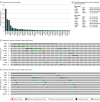Spectrum of Somatic Cancer Gene Variations Among Adults With Appendiceal Cancer by Age at Disease Onset
- PMID: 33295976
- PMCID: PMC7726634
- DOI: 10.1001/jamanetworkopen.2020.28644
Spectrum of Somatic Cancer Gene Variations Among Adults With Appendiceal Cancer by Age at Disease Onset
Erratum in
-
Error in Reporting of Age Variable in Database.JAMA Netw Open. 2021 Mar 1;4(3):e216703. doi: 10.1001/jamanetworkopen.2021.6703. JAMA Netw Open. 2021. PMID: 33769501 Free PMC article. No abstract available.
Abstract
Importance: The incidence of appendiceal cancer (AC) is rising, particularly among individuals younger than 50 years (early-onset AC), with unexplained etiologies. The unique spectrum of somatic cancer gene variations among patients with early-onset AC is largely undetermined.
Objective: To characterize the frequency of somatic variations and genomic patterns among patients with early-onset (age <50 years) vs late-onset (age ≥50 years) AC.
Design, setting, and participants: This cohort study included individuals aged 18 years and older diagnosed with pathologically verified AC. Cases with clinical-grade targeted sequencing data from January 1, 2011, to December 31, 2019, were identified from the international clinicogenomic data-sharing consortium American Association for Cancer Research Project Genomics Evidence Neoplasia Information Exchange (GENIE). Data analysis was conducted from May to September 2020.
Exposures: Age at disease onset.
Main outcomes and measures: Somatic variation prevalence and spectrum in AC patients was determined. Variation comparisons between early-onset and late-onset AC were evaluated using multivariable logistic regression with adjustment for sex, race/ethnicity, histological subtype, sequencing center, and sample type.
Results: In total 385 individuals (mean [SD] age at diagnosis, 56.0 [12.4] years; 187 [48.6%] men; 306 [79.5%] non-Hispanic White individuals) with AC were included in this study, and 109 patients (28.3%) were diagnosed with early-onset AC. Race/ethnicity differed by age at disease onset; non-Hispanic Black individuals accounted for a larger proportion of early-onset vs late-onset cases (9 of 109 [8.3%] vs 11 of 276 [4.0%]; P = 0.04). Compared with patients aged 50 years or older at diagnosis, patients with early-onset AC had significantly higher odds of presenting with nonsilent variations in PIK3CA, SMAD3, and TSC2 (PIK3CA: odds ratio [OR], 4.58; 95% CI, 1.72-12.21; P = .002; SMAD3: OR, 7.37; 95% CI, 1.24-43.87; P = .03; TSC2: OR, 12.43; 95% CI, 1.03-149.59; P = .047). In contrast, patients with early-onset AC had a 60% decreased odds of presenting with GNAS nonsilent variations compared with patients with late-onset AC (OR, 0.40; 95% CI, 0.21-0.76, P = .006). By histological subtype, young patients with mucinous adenocarcinomas of the appendix had 65% decreased odds of variations in GNAS compared with late-onset cases in adjusted models (OR, 0.35; 95% CI, 0.15-0.79; P = .01). Similarly, patients with early-onset nonmucinous appendiceal adenocarcinomas had 72% decreased odds of presenting with GNAS variations vs late-onset cases, although these findings did not reach significance (OR, 0.28; 95% CI, 0.07-1.14; P = .08). GNAS and TP53 variations were mutually exclusive in ACs among early-onset and late-onset cases (P < .05).
Conclusions and relevance: In the study, AC diagnosed among younger individuals harbored a distinct genomic landscape compared with AC diagnosed among older individuals. Development of therapeutic modalities that target these unique molecular features may yield clinical implications specifically for younger patients.
Conflict of interest statement
Figures
References
-
- National Comprehensive Cancer Network Colon cancer (version 3.2020). Accessed June 4, 2020. https://www.nccn.org/professionals/physician_gls/pdf/colon.pdf
Publication types
MeSH terms
Substances
Grants and funding
LinkOut - more resources
Full Text Sources
Research Materials
Miscellaneous


